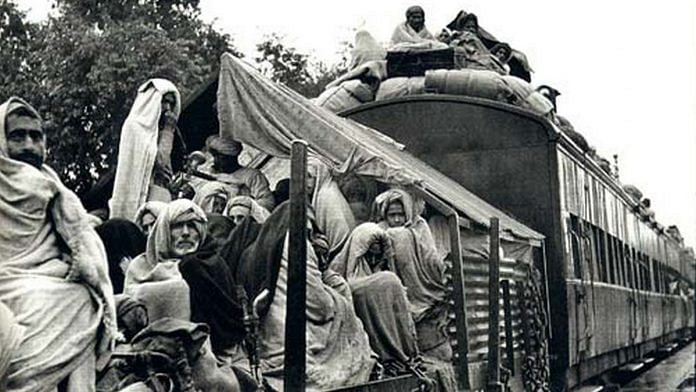Jagan waleyan raj ke luttya ae
Soye tussi vi o, soye assi vi aan
Laali akhiyan di pai dasdi aay
Roye tusi vi ho, roye assi vi aan
(Those who were awake have looted us mercilessly,
You were asleep, as were we.
The redness in your eyes shows
You cried too, as did we)
These famous verses from poet Ustad Daman describe the heart-breaking scenes from the Partition in 1947. Refugees in kafilas (caravans) trudge across the newly created border, but in opposite directions, pause and look at each other in despair, and then continue. Both looted, both weeping.
There were no winners in the manner in which the Partition was executed, as it impacted over 18 million people. It was India’s Holocaust, and Pakistan’s too. And the wound festered for years under the veil of silence. A large part of history was erased with the generation that witnessed the Partition because the dead do not speak.
This is why Prime Minister Narendra Modi’s tweet, recognising the horrors of Partition and the enormity of the pain and suffering imposed upon innocent people, needs to be lauded. Those of us who have struggled for years to get this injustice of “unremembering” rectified, feel almost as though the debt we owe those who lost their homes, lives and loved ones is somewhat being repaid.
Also Read: The India-Pakistan border haunted journalist Kuldip Nayar all his life after Partition
The need for a Partition museum
When we began setting up the world’s first Partition Museum in Amritsar, more than six years ago, it was a shock to realise that there was no memorial, no building, no piece of sculpture — nothing, anywhere in the world, dedicated to the world’s largest forced migration. That was why we created a People’s Museum. It was not about the great political leaders of the time, rather it is about those forgotten millions, on both sides of the border, who were uprooted mercilessly, and sometimes overnight. It was not just about the violence that took place, but about the migration, the divisions and the painful resettlement. There has been a huge gap in our historical understanding of Partition, and of the sheer human cost of the event because all we were taught was that Hindus and Muslims could not live together.
In fact, in the Partition Museum at Amritsar, we have hundreds of oral narratives that reiterate the close inter-communal bonds that existed in the years before 1947, and many that continued after it, too. The irony is that while the Partition in Punjab was hard, the migration was over in a few years, in Bengal, the partition-imposed migration went on for decades. The pain and suffering culminated in the cruel events of Dandakaranya when refugees were pushed into regions they did not want to go, and shot and tortured, if they resisted. Our newly launched Partition Museum on wheels, inside Kolkata’s historic trams in Esplanade, is an attempt to pay homage to those who were a part of it.
At the Partition Museum in Amritsar, which was inaugurated on the 70th anniversary of India’s Partition in 2017, we chose 17 August as the Partition Remembrance Day. This was the date when the Radcliffe award was announced in 1947, and many in Punjab and Bengal discovered for the first time, two days after Independence, which country they were living in. In fact, apart from the leaders and government officers, the details had been shrouded in secrecy. Many had been assured that Lahore would be in India and had just bought properties that they had to abandon. My own parents were forced to flee Lahore, and my mother’s family left with just a small suitcase. They could never go back.
Also Read: India-Pakistan diplomacy wasn’t poisoned after violent Partition. Officials kept their calm
Recognition by the United Nations
However, the Partition Remembrance Day announced by a small NGO like ours is barely noticed. But when it is announced by the prime minister, it has a completely different impact. It brings the issue onto the international stage, which is something we have been hoping for and working towards. Like Holocaust Day, it should also be recognised by the United Nations, and commemorated internationally so that those who lost their homes, were raped and murdered, and orphaned, will finally be recognised as well. The message should be, as it is in our museum, that this should never happen again. These kinds of divisions are dangerous and inhumane.
For people who ask why this memorialisation is required, the answer is simple. In India, we know our epics better than our history. Let us at least try to remember the huge price of our Independence. Not just the sacrifices of millions of nameless freedom fighters, but also of those who were forced to migrate.
Now, as we create another Museum dedicated to the Partition of India in Delhi — our NGO, with its young team, is in a race against time, gathering information and material about all those who are an important part of our collective historical narrative. In these museums, the centrepieces are their memories and the objects they, or their families, share with us.
I can only say, thank you, Modi ji, for reiterating their importance to the country and the world.
The author is the Founder-Trustee, Chair of The Arts And Cultural Heritage Trust, which set up the Partition Museum, Amritsar, and is now setting up the Partition Museum at the Dara Shikoh Library building in Delhi.
(Edited by Srinjoy Dey)






